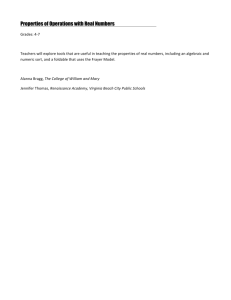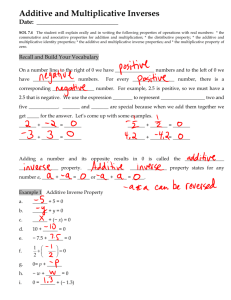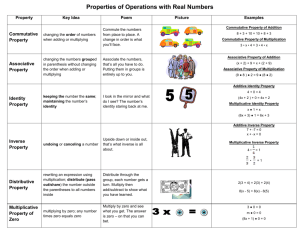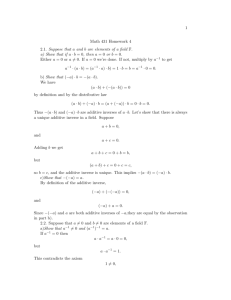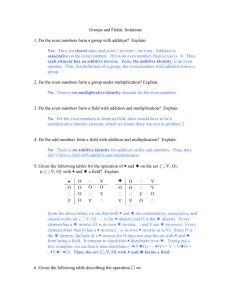Math 320-1 Spring 2006 The Field Axioms A field is a set F with
advertisement
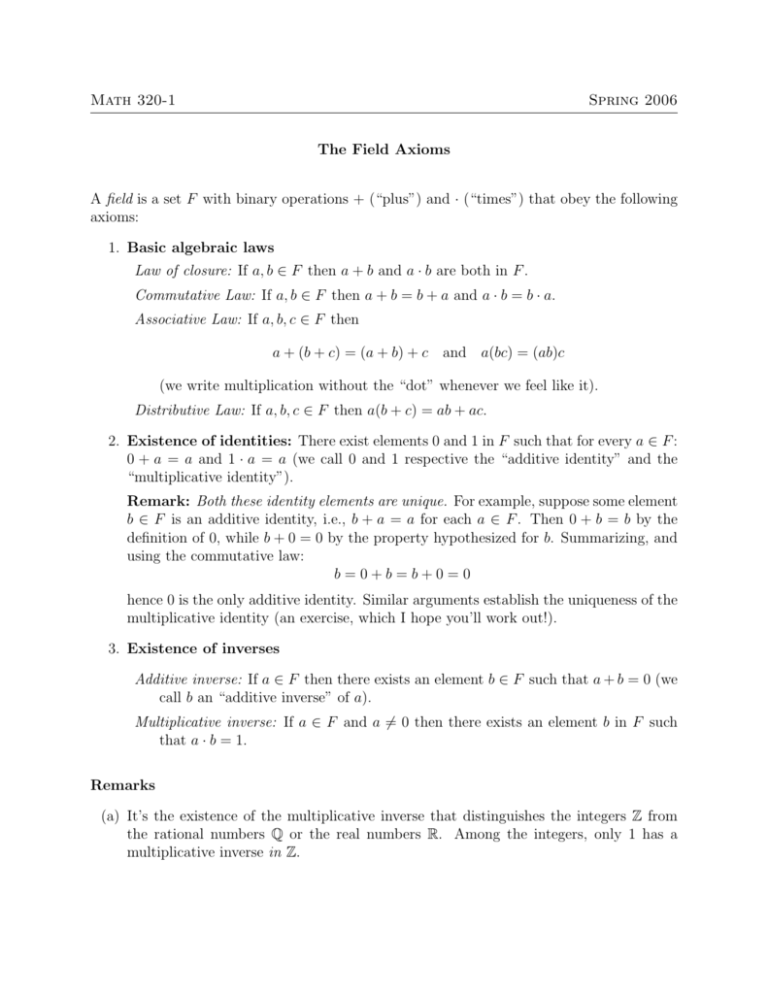
Math 320-1
Spring 2006
The Field Axioms
A field is a set F with binary operations + (“plus”) and · (“times”) that obey the following
axioms:
1. Basic algebraic laws
Law of closure: If a, b ∈ F then a + b and a · b are both in F .
Commutative Law: If a, b ∈ F then a + b = b + a and a · b = b · a.
Associative Law: If a, b, c ∈ F then
a + (b + c) = (a + b) + c and a(bc) = (ab)c
(we write multiplication without the “dot” whenever we feel like it).
Distributive Law: If a, b, c ∈ F then a(b + c) = ab + ac.
2. Existence of identities: There exist elements 0 and 1 in F such that for every a ∈ F :
0 + a = a and 1 · a = a (we call 0 and 1 respective the “additive identity” and the
“multiplicative identity”).
Remark: Both these identity elements are unique. For example, suppose some element
b ∈ F is an additive identity, i.e., b + a = a for each a ∈ F . Then 0 + b = b by the
definition of 0, while b + 0 = 0 by the property hypothesized for b. Summarizing, and
using the commutative law:
b=0+b=b+0=0
hence 0 is the only additive identity. Similar arguments establish the uniqueness of the
multiplicative identity (an exercise, which I hope you’ll work out!).
3. Existence of inverses
Additive inverse: If a ∈ F then there exists an element b ∈ F such that a + b = 0 (we
call b an “additive inverse” of a).
Multiplicative inverse: If a ∈ F and a 6= 0 then there exists an element b in F such
that a · b = 1.
Remarks
(a) It’s the existence of the multiplicative inverse that distinguishes the integers Z from
the rational numbers Q or the real numbers R. Among the integers, only 1 has a
multiplicative inverse in Z.
(b) Additive and multiplicative inverses are unique. To see this for additive inverses, suppose b and b0 are additive inverses for a ∈ F . Then 0 = a + b0 , so adding b to both
sides:
b+0 =
=
=
=
b + (a + b0 )
(b + a) + b0 (Associate law of addition)
0 + b0 (Commutative law of addition and “b an add. inverse of a”)
b0 (since 0 is the additive identity).
Thus a has only one additive inverse. We call this “−a”.
Similarly, if a ∈ F is not 0 then a has only one multiplicative inverse (another exercise
I hope you’ll do); we call this one a−1 , or a1 .
(c) Examples: We’ve already called attention to the fields R of real numbers and Q of
rational numbers. Here are two others:
– Quadratic extensions of the rationals. We’ll
√ just think about one of these—you
can easily supply
√ of
√ other examples. Let Q( 2) denote the set of all real numbers
the form a + b 2, where a and b are rational. Then it’s easy to check that Q( 2)
is closed under ordinary addition and multiplication, and obeys all the axioms for
a field, except possibly for the existence of multiplicative inverses. But this too is
true, and I leave it to you as an exercise to prove it.
– The field C of complex numbers. We write each element of this field as a + bi
where a and b are real numbers and i is the “imaginary” element whose defining
property is i2 = −1. We define addition and multiplication in the obvious way,
but for multiplication we always reduce powers of i to either 1, i, −i or −1 using
the equation i2 = −1. Note that, in the spirit of the previous example, you can
think of C as the “quadratic extension” R(i) of the real field.
– The “binary field.” This is the two-element set Z2 = {0, 1}, with operations
defined like this: 0 + 0 = 1 + 1 = 0, 0 + 1 = 1 + 0 = 1, 0 · 0 = 1 · 0 = 0 · 1 = 0,
and 1 · 1 = 1.
Exercise: check that Z2 is a field. In particular, identify the additive and multiplicative identities and inverses.
Ordered Fields
An ordered field is a field on which there is defined on pairs of elements a relation “<” that
obeys the following axioms:
Trichotomy: For each pair of elements a, b ∈ F , exactly one of these conditions holds:
a < b, b < a, or a = b.
Transitivity: If a, b, c ∈ F with a < b and b < c then a < c.
2
Additivity: If a, b ∈ F with a < b, then a + c < b + c for every c ∈ F .
Multiplicativity: If a, b ∈ F with a < b then:
• ac < bc whenever c ∈ F with c > 0, and
• bc < ac whenever c ∈ F with c < 0
Examples. The field R of real numbers, with its usual order, is an ordered field, as is the
field Q of rational numbers with the order it inherits from the reals.
Proposition (Example 1.2 of our text): If F is an ordered field then a2 =: a · a > 0 for
every non-zero a ∈ F .
Proof. Either a < 0 or a > 0 by Trichotomy. If a > 0 then a2 = a · a > 0 by the first
multiplicative property. If a < 0 then the result follows in similar fashion from the second
multiplicative property.
Corollary. In any ordered field: −1 < 0 < 1.
Proof. 1 6= 0, hence 1 = 12 > 0 by the Proposition. By additivity
−1 = −1 + 0 < −1 + 1 = 0
which completes the proof.
Corollary. There’s no way to make Z2 into an ordered field.
Proof. Suppose there’s an ordering “<” on Z2 that does make it into an ordered field. Then
by the previous Corollary, 0 < 1, so by additivity 1 = 0 + 1 < 1 + 1 = 0, i.e., both 0 < 1 and
1 < 0, which contradicts the trichotomy axiom. So such an ordering can’t exist.
Extra Credit Problem. Verify that the complex numbers C, with their usual addition
and multiplication, form a field. Then show that there’s no way to make C into an ordered
field.
3

